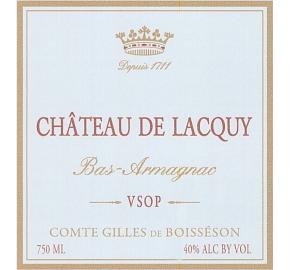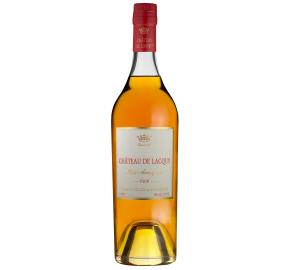This product is no longer available. Please choose another vintage above.
Chateau Lacquy - VSOP (7 Years old) NV
- Country France
- Region SOUTH-WEST
- Appellation Armagnac
- UPC 8 73964 00188 4
Tasting notes
Clear amber color with gold reflections. Fragrant and sweet nose of vanilla, toasted nuts, white flowers and pear compote. Complex, rich and fruity attack, slightly sweet with good acidic balance. Round in the mouth with creamy flavors of vanilla, spices and nuts. Long, expressive finish. This is a remarkable product comparable to the best brandies.
Background
Armagnac is the oldest brandy distilled in France and it is produced in the Armagnac region in Gascony, southwest France. However, production is very small because of its natural and artisanal production methods and so most of it is consumed in France. Aquitaine Wine Company now represents Château de Lacquy, one of the most prestigious and legendary producers in the Bas-Armagnac and a part of the five "Cru Legendaire" (legendary growths).
Château de Lacquy has belonged to the aristocratic Boisseson family since 1711, thus making it the oldest family-owned producer of Armagnac. Though Château de Lacquy comprises 400 hectares of forests and agricultural land, only 18 hectares of the estate are dedicated to the production of Bas Armagnac, and annual production of VSOP is 2000 cases/year.
Château de Lacquy may be considered as the Armagnac of the Tsars because of its long and illustrious relationship with the Russian Imperial Family. During the French Revolution, Paul-Matthieu, the Marquis de Boisseson, left France to take refuge in the court of the Russian Tsars. Because of his vast military experience, he rose to become a Major General of the Russian Empire, and was even responsible for sending troops to America in 1779 to support the American Independence War. His son, Louis-Hercule, Marquis de Boisseson, was educated in the elite Russian Cadet Corps under the patronage of the Russian Emperor, Alexander 1st. Initially a Captain of a Regiment of Lancers of the Imperial Guard during the Russian Campaign, Louis-Hercule was promoted Colonel of his regiment by the Tsar on the battlefield in Germany in 1813. His son Constantin, Marquis de Boisseson, was the godson of the Grand-Duke Constantin of Russia, the Tsar's brother, and is the direct ancestor of the present owner of the estate, the Count Gilles de Boisseson.
Château de Lacquy has belonged to the aristocratic Boisseson family since 1711, thus making it the oldest family-owned producer of Armagnac. Though Château de Lacquy comprises 400 hectares of forests and agricultural land, only 18 hectares of the estate are dedicated to the production of Bas Armagnac, and annual production of VSOP is 2000 cases/year.
Château de Lacquy may be considered as the Armagnac of the Tsars because of its long and illustrious relationship with the Russian Imperial Family. During the French Revolution, Paul-Matthieu, the Marquis de Boisseson, left France to take refuge in the court of the Russian Tsars. Because of his vast military experience, he rose to become a Major General of the Russian Empire, and was even responsible for sending troops to America in 1779 to support the American Independence War. His son, Louis-Hercule, Marquis de Boisseson, was educated in the elite Russian Cadet Corps under the patronage of the Russian Emperor, Alexander 1st. Initially a Captain of a Regiment of Lancers of the Imperial Guard during the Russian Campaign, Louis-Hercule was promoted Colonel of his regiment by the Tsar on the battlefield in Germany in 1813. His son Constantin, Marquis de Boisseson, was the godson of the Grand-Duke Constantin of Russia, the Tsar's brother, and is the direct ancestor of the present owner of the estate, the Count Gilles de Boisseson.
Viticulture
The village of LACQUY is located in the western end of the Armagnac growing area, also known as "Grand-Bas-Armagnac," and considered as the best growth of the region. The soil of light, tawny marine sand, with a large proportion of shell sediments, and clay creates a highly perfumed brandy with notes of dried prunes, vanilla, cocoa and white flowers, with a soft attack and a long finish. Château de Lacquy has four different grape varietals.
- 35% BACCO 22A (today about 5ha). Very resistant to diseases. Bacco is very good for distillation, producing a deep and complex Armagnac, which ages properly and retains its qualities when old. BACCO 22A is an ingredient of most current old armagnacs.
- 35% COLOMBARD (today about 5 ha). It is a rather seldom used type of grape in the region. At Lacquy it produces very light and elegant armagnacs with floral and citrus scents.
- 15% FOLLE BLANCHE (today about 5 ha) was the traditional Armagnac plant which disappeared in the mid XXth century. Folle Blanche produces delicate armagnac that often display a floral character and a great degree of finesse.
- 15% UGNI BLANC (today about 2 ha). Largely planted in the seventies, it is the major grape in the region. From Italian origin, it allows a large production of low alcohol wine. Distillation of a mix of BACCO and UGNI BLANC produces great armagnacs, both soft and well structured.
- 35% BACCO 22A (today about 5ha). Very resistant to diseases. Bacco is very good for distillation, producing a deep and complex Armagnac, which ages properly and retains its qualities when old. BACCO 22A is an ingredient of most current old armagnacs.
- 35% COLOMBARD (today about 5 ha). It is a rather seldom used type of grape in the region. At Lacquy it produces very light and elegant armagnacs with floral and citrus scents.
- 15% FOLLE BLANCHE (today about 5 ha) was the traditional Armagnac plant which disappeared in the mid XXth century. Folle Blanche produces delicate armagnac that often display a floral character and a great degree of finesse.
- 15% UGNI BLANC (today about 2 ha). Largely planted in the seventies, it is the major grape in the region. From Italian origin, it allows a large production of low alcohol wine. Distillation of a mix of BACCO and UGNI BLANC produces great armagnacs, both soft and well structured.
Vinification
There are 2 main differences between Armagnac and Cognac. First, Armagnac is distilled once and non-stop between 52% and 72% in a very specific continuous still. This results in a more fragrant and tasty spirit than Cognac, which is distilled twice at 75% per volume. Second, due to its relatively low % of alcohol, Armagnac is not diluted with water; therefore, there is no need to add flavor or color enhancers, as in the case of Cognac. Armagnac is naturally a more artisanal product.
- At Chateau de Lacquy, each grape varietal is harvested and vinified separately; each wine is then distilled separately at 52%.
- Distillation begins very early (November and December) as soon as fermentation of the wine is over and without having tampered with the wine at all (no sulfites added).
- The copper still built in 1939, belongs to the estate and is wood heated.
- Chateau de Lacquy uses at least 50% new oak barrels each year. Armagnac drips straight into the barrels where it will mature until it is assembled and bottled.
- The barrels are made by local coopers from locally grown oak (average capacity of 420 litres). The "douves" (pieces of wood which are joined to form the cask) are hand cut with axes to avoid cutting the fibers, which play an important part in allowing a progressive impregnation of "tannins" into the brandy.
- During barrel aging, a part of the alcohol and water evaporates naturally (this evaporation of about 0,4% per year is known as the"angels'share"); this results in the development of more complex aromas, a caramel color, softness and a lower alcohol content.
- At Lacquy, the armagnacs made from different varietals are aged separately. After 5 to 7 years of aging in new oak barrels, when the armaganac has obtained its lovely caramel coloring, it is transferred into older oak casks where it continues aging without gaining more colour or tannins.
- Aged 8 years.
- At Chateau de Lacquy, each grape varietal is harvested and vinified separately; each wine is then distilled separately at 52%.
- Distillation begins very early (November and December) as soon as fermentation of the wine is over and without having tampered with the wine at all (no sulfites added).
- The copper still built in 1939, belongs to the estate and is wood heated.
- Chateau de Lacquy uses at least 50% new oak barrels each year. Armagnac drips straight into the barrels where it will mature until it is assembled and bottled.
- The barrels are made by local coopers from locally grown oak (average capacity of 420 litres). The "douves" (pieces of wood which are joined to form the cask) are hand cut with axes to avoid cutting the fibers, which play an important part in allowing a progressive impregnation of "tannins" into the brandy.
- During barrel aging, a part of the alcohol and water evaporates naturally (this evaporation of about 0,4% per year is known as the"angels'share"); this results in the development of more complex aromas, a caramel color, softness and a lower alcohol content.
- At Lacquy, the armagnacs made from different varietals are aged separately. After 5 to 7 years of aging in new oak barrels, when the armaganac has obtained its lovely caramel coloring, it is transferred into older oak casks where it continues aging without gaining more colour or tannins.
- Aged 8 years.


